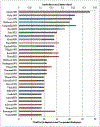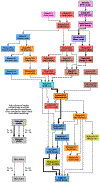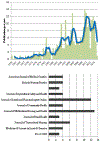Research Trends in Amish Population Health, a Growing Literature about a Growing Rural Population
- PMID: 34367718
- PMCID: PMC8341032
Research Trends in Amish Population Health, a Growing Literature about a Growing Rural Population
Abstract
The Amish are an endogamous rural population experiencing rapid growth; consequently, they have attracted the attention of population health researchers and service providers. With approximately one quarter of all Amish studies publications now devoted to population health (n=246), the time is ripe to review research trends. Using bibliometric measures, we map the genealogy, influence, and configuration of Amish health publications. Amish population health research has (1) a health culture-focused core with clusters representing social science and health practice, (2) peripheral clusters addressing health conditions-mental, physical, and injury/safety-and (3) several clusters straddling both. We identify fruitful interdisciplinary studies and recommend researchers investigating health culture and conditions seek ways to integrate their research agendas. This article represents a pivot-point for Amish population health research, for it provides a first-ever bibliometric mapping, allowing researchers to more easily locate their work within the literature and identify opportunities for interdisciplinary collaborations.
Keywords: Bibliometric analysis; citation network analysis; ethnicity and population health; meta-review; religion and population health.
Figures





Similar articles
-
The Cultural and Religious Complexities of Amish-Focused Mental Health Conditions Research: Insights from an Exhaustive Narrative Review and Case Study of Counseling Controversies.Ment Health Relig Cult. 2023;26(9):908-924. doi: 10.1080/13674676.2023.2216146. Epub 2024 Jan 31. Ment Health Relig Cult. 2023. PMID: 38698810 Free PMC article.
-
The Amish health culture and culturally sensitive health services: An exhaustive narrative review.Soc Sci Med. 2020 Nov;265:113466. doi: 10.1016/j.socscimed.2020.113466. Epub 2020 Oct 21. Soc Sci Med. 2020. PMID: 33153874 Free PMC article. Review.
-
Physical health conditions of the Amish and intervening social mechanisms: an exhaustive narrative review.Ethn Health. 2022 Nov;27(8):1952-1978. doi: 10.1080/13557858.2021.1968351. Epub 2021 Aug 19. Ethn Health. 2022. PMID: 34410871 Free PMC article. Review.
-
Creating Culturally Competent and Responsive Mental Health Services: A Case Study Among the Amish Population of Geauga County, Ohio.J Behav Health Serv Res. 2018 Oct;45(4):627-639. doi: 10.1007/s11414-018-9612-0. J Behav Health Serv Res. 2018. PMID: 29728913
-
Amish Culture and Their Utilization of Burns and Wounds Ointment for the Treatment of Burns.Holist Nurs Pract. 2016 Mar-Apr;30(2):78-87. doi: 10.1097/HNP.0000000000000133. Holist Nurs Pract. 2016. PMID: 26871246
Cited by
-
The Cultural and Religious Complexities of Amish-Focused Mental Health Conditions Research: Insights from an Exhaustive Narrative Review and Case Study of Counseling Controversies.Ment Health Relig Cult. 2023;26(9):908-924. doi: 10.1080/13674676.2023.2216146. Epub 2024 Jan 31. Ment Health Relig Cult. 2023. PMID: 38698810 Free PMC article.
-
Profiles of Major Amish Settlements in North America: A Guide for Researchers and Service Providers.J Amish Plain Anabapt Stud. 2024;12(1):47-79. doi: 10.62192/japas.v12i1-2n05. J Amish Plain Anabapt Stud. 2024. PMID: 40008379 Free PMC article.
-
Amish peoplehood: A critical synthesis of eight decades of theorizing.J Rural Stud. 2025 Aug;118:103670. doi: 10.1016/j.jrurstud.2025.103670. Epub 2025 May 6. J Rural Stud. 2025. PMID: 40538600
-
Population-Wide Vaccination Hesitancy among the Amish: A County-Level Study of COVID-19 Vaccine Adoption and Implications for Public Health Policy and Practice.Popul Res Policy Rev. 2023;42:70. doi: 10.1007/S11113-023-09816-9. Epub 2023 Jul 30. Popul Res Policy Rev. 2023. PMID: 39867483 Free PMC article.
-
The Amish health culture and culturally sensitive health services: An exhaustive narrative review.Soc Sci Med. 2020 Nov;265:113466. doi: 10.1016/j.socscimed.2020.113466. Epub 2020 Oct 21. Soc Sci Med. 2020. PMID: 33153874 Free PMC article. Review.
References
APPENDIX: Amish Health Literature References—246 Studies from 1958 to Spring 2020
-
- Aaland Mary, and Hlaing Thein. 2004. “Amish Buggy Injuries in the 21st Century: A Retrospective Review from a Rural Level II Trauma Center.” American Surgeon 70(3):228–34. - PubMed
-
- Acheson Louise. 1994. “Perinatal, Infant, and Child Death Rates among the Old Order Amish.” American Journal of Epidemiology 139(2):173–83. - PubMed
-
- Adams Carolyn, and Leverland Michael. 1986. “The Effects of Religious Beliefs on the Health Care Practices of the Amish.” Nurse Practitioner 11(3):58–67. - PubMed
-
- Agarwala Richa, Biesecker Leslie, Hopkins Katherine, Francomano Clair, and Schäffer Alejandro. 1998. “Software for Constructing and Verifying Pedigrees within Large Genealogies and an Application to the Old Order Amish of Lancaster County.” Genome Research 8(3):211–21. - PubMed
-
- Agarwala Richa, Biesecker Leslie, and Schäffer Alejandro. 2003. “Anabaptist Genealogy Database.” American Journal of Medical Genetics Part C: Seminars in Medical Genetics 121C(1):32–37. - PubMed
References
-
- Anderson Cory, and Donnermeyer Joseph. 2013. “Where Are the Plain Anabaptists?” Journal of Amish and Plain Anabaptist Studies 1(1):1–25. 10.18061/1811/54898 - DOI
-
- Anderson Cory. 2014. “Horse and Buggy Crash Study II: Overstretching the Slow-Moving Vehicle Emblem’s Abilities: Lessons from the Swartzentruber Amish.” Journal of Amish and Plain Anabaptist Studies 2(1):100–15. 10.18061/1811/59687 - DOI
-
- Anderson Cory. 2017a. “Seventy-five Years of Amish Studies, 1942 to 2017: A Critical Review of Scholarship Trends (with an Extensive Bibliography).” Journal of Amish and Plain Anabaptist Studies 5(1):1–65. 10.18061/1811/81076 - DOI
Grants and funding
LinkOut - more resources
Full Text Sources
